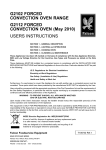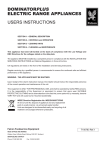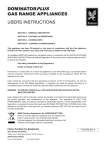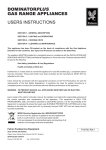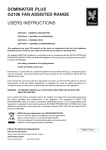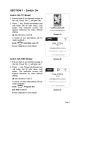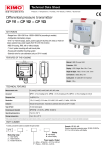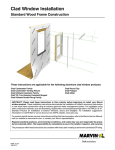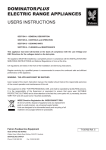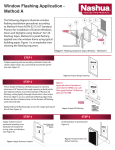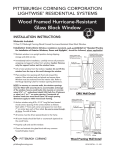Download User Manual - Falcon Foodservice Equipment
Transcript
E2102 Forced Convection Oven Range E2112 Forced Convection Oven USERS INSTRUCTIONS SECTION 1 - GENERAL DESCRIPTION SECTION 2 - CONTROLS and OPERATION SECTION 3 - COOKING HINTS SECTION 4 - CLEANING and MAINTENANCE This appliance has been CE-marked on the basis of compliance with the Low Voltage and EMC Directives for the voltages stated on the Data Plate. IMPORTANT This appliance must only be installed by a competent person in compliance with the regulations in force at the time. UK regulations are listed on the front of the Installation and Service Manual. Regular servicing by a qualified person is recommended to ensure the continued safe and efficient performance of the appliance. WARNING - THIS APPLIANCE MUST BE EARTHED! Upon receipt of this manual, the installer should instruct a responsible person (or persons) as to the correct operation and maintenance of the unit. This equipment is designed FOR PROFESSIONAL USE ONLY and be operated by QUALIFIED persons. It is the responsibility of the supervisor or equivalent to ensure that the user wears SUITABLE PROTECTIVE CLOTHING. Attention should also be drawn to the fact that some parts of the appliance will, by necessity, become VERY HOT and could cause burns if touched accidentally. WEEE Directive Registration No. WEE/DC0059TT/PRO At end of unit life, dispose of appliance and any replacement parts in a safe manner, via a licenced waste handler. Units are designed to be dismantled easily and recycling of all material is encouraged whenever practicable. Falcon Foodservice Equipment HEAD OFFICE AND WORKS Wallace View, Hillfoots Road, Stirling FK9 5PY SERVICELINE CONTACT PHONE - 01438 363 000 FAX - 01438 369 900 T100508 Ref. 1 SECTION 1 - GENERAL DESCRIPTION This document covers the operation of the folowing models - E2102 Range Single forced convection oven with three solid rectangular hotplates. OR Single forced convection oven with two solid rectangular hotplates and two circular, quick acting hotplates. E2112 Oven Forced convection oven. (Single Tier) E2112/2 Oven 2 x Forced convection oven. (Double Tier) The hob is constructed of cast iron and the hotplates are controlled by six position rotary switches. The oven has four grid shelves with safety stops, on fixed position runners. One or more of these shelves may be removed to accommodate larger items e.g. chickens. The elements are located below the oven which is heated by conduction and convection. A door operated switch controls the fan and heat functions via the thermostat to achieve rapid cooking by forced convection SECTION 2 - CONTROLS and OPERATION OVEN The controls are mounted on a panel at the RH side of the oven. These consist of: Thermostat ON/OFF amber light Thermostat knob MAINS ON red light POWER ON/OFF switch Lamp push button Timer knob Switching On Ensure mains supply is ON (RED indicator lights). Press the power rocker switch button and close the doors. The fan will come on. Turn the thermostat to the required temperature setting. The AMBER indicator will light and remain so until this temperature is reached. It will then go out and food may be loaded into the oven. Opening the oven doors will result in automatic shut down of the fan and heat. Switching Off 1. During a continuous working cycle, open the doors (This automatically switches off the fan and heat). 2. To shut-down with doors closed, press I/O switch to Off. (This will cut the supply to door-operated switch and will enable the doors to be closed without Fan/Heat coming on and/or having to switch off at mains supply. Timer The timer knob is graduated in minutes and should be set to required cooking time when food is placed in the oven. It should be turned fully clockwise and then back to desired time. When set time has elapsed, warning buzzer will sound continuously until operator switches it OFF. The timer does not switch oven off but provides an audible warning when cooking cycle is complete. Oven Light This illuminates oven from rear via a push-button switch mounted on control panel. Hotplates The hotplate arrangement consists of either three rectangular plates or two rectangular and two circular, energy saving hotplates. Each plate is controlled by a six heat switch which controls variable temperatures from Setting 1 (lowest) rising progressively to Setting 6 (highest). A neon is located next to each switch to indicate that the plate is ON. The requisite setting for simmering or fast boiling pots of varying sizes will quickly be found by experience. In order to achieve efficient operation of the plates, it is essential that good contact be made between the plate and the utensil. Ground based pots should be used and the plate surface must be in good condition. Spillage should not be allowed to accumulate around the edges of a hotplate, it will burn on and become difficult to remove. Spillage trays are positioned below the plates. These may be readily withdrawn for emptying and cleaning when the range is cool. Important To ensure long life of the hotplates and to conserve energy, DO NOT leave the plates switched on when not in use. Particularly at high settings. If for any reason it is considered necessary to retain a plate on heat, reduce the setting to Mark 2 or 3. Circular plates embody a temperature limiting device which automatically shuts down part of the element circuit should it become overheated when left on without a pot on it. The full circuit is reacivated when a pot is placed upon the plate. Lift Off Fryplate (Optional Extra) This is placed over the fast boiling plates with the drain slot to the front and the pads on the underside locating around the rim of the boiling plates. The drainage tray slides in from either side at the front below the slot during operation (see diagram. It may be removed, without disturbing the fryplate, for draining and/or washing. SECTION 3 - COOKING HINTS Using the Oven When the oven has reached working temperature, the AMBER light will go out. Operate ON/OFF as the thermostat maintains the temperature. Opening the doors or switching the power button off shut down the fan and thermostat. Pre-Heating Time Allow at least 45 minutes from switching on a cold oven, irrespective of the desired temperature setting. Insert the food as quickly as possible and close the doors firmly. Loading All four shelves may be used simultaneously and normally, no manipulation of items on the shelves is necessary. Containers of food up to 75mm in depth can be prepared when using four shelves. If deeper trays require to be cooked, i.e. chicken, one or more shelves may be removed as necessary. The shelves have stops to prevent accidental removal. To remove, lift the stops above the front of the side runners. When loading, the oven doors should be kept open for as short a time as possible in order to minimise heat loss. Tray Size The oven will accept gastronorm Trays of dimensions 650mm x 530mm or conventional trays up to this size. Trays and dishes must always be located centrally on the shelves. Heating the Fryplate Turn both boiling plate controls to 6. It is advisable to have both plates on simultaneously for even-ness of heating across the fryplate. The normal time for heating to 200oC is 25 minutes with the controls switched FULL ON. As the Boiling Plates are thermostatically controlled, no adjustment of the controls is necessary to maintain maximum temperature. When lower cooking temperatures are required e.g. 120oC for eggs, set the controls at 3 and allow 10 minutes heat up time. Baking TEMP TIME No. of SHELVES Scones and Small Buns 230 15 mins 4 Vol-au-Vent Cases 200 10 mins 4 Gingerbread, etc 150 2 hours 4 Meringue (white) 100 2 hours 30 minutes 4 Shortbread 175 15 to 20 minutes 4 Biscuits 175 10 to 15 minutes 4 TEMP TIME No. of SHELVES 175 45 mins 4 Fish Poached Haddock Puddings TEMP TIME No. of SHELVES Baked Rice 175 1 hr to 1 hr 15 minutes 4 Bakewell Tarts 190 30 to 45 minutes 4 Large Sponge Slab (25 - 38mm deep) 200 30 mins 4 Yorkshire Pudding (Large) 240 25 mins 4 TEMP TIME No. of SHELVES Meats Lamb, Roast Beef, etc. Chicken 150 - 175 25 minutes per 0.5kg 1.8kg (4lbs) 150 in 1 hour 2 2 Braised Steak 175 1 hour 30 mins - 2hrs 4 Pork Chops 175 15 to 20 minutes 4 Lancashire Hotpot 175 1 hour 30 mins - 2hrs 4 Cornish Pasties 190 30 mins 4 TEMP TIME No. of SHELVES Roast Potatoes 200 30 mins 4 Baked Potatoes 215 45 mins 4 Tomatoes 190 8 to 10 minutes 4 Toad in the Hole 215 30 mins 4 Baked Apples 200 30 mins 4 Miscellaneous SECTION 4 - CLEANING and MAINTENANCE Importance BEFORE CLEANING IS UNDERTAKEN, ENSURE THAT THE POWER SUPPLY IS ISOLATED FROM MAINS. APPLIANCE MUST NOT BE CLEANED WITH A JET OF WATER, OR STEAM CLEANED. General Clean with soapy water as often as possible then rinse and dry thoroughly. Grease should be removed using nylon or scotch pads with care, especially when new as these may scratch the enamelled surfaces. Before removing any parts, note their arrangement and replace them in the same positions after completion. Oven The oven shelves may be removed for cleaning by lifting the stops over the front side of the runners. The enamelled linings should not be removed, except in the event of servicing. Daily cleaning is recommended, preferably while oven is still warm. Use of a disposable cloth with a proprietary detergent is the best method. For stubborn deposits, a proprietary oven cleaner may be used in accordance with its manufacturer's instruction. Hotplate and Fryplate A smooth bladed metal scraper is handy for removing deposits of burned-on grease from hotplate and fryplate surface. The hotplate spillage trays are simply removed for cleaning by sliding these out from front of range.




